
Content
Bilirubin is produced as a by-product when old blood cells are replaced with new ones. The liver is responsible for breaking down bilirubin into a form that can be excreted from the body. Excessive levels of bilirubin in the blood (hyperbilirubinemia) causes jaundice (yellowing of the skin and whites of the eyes) and indicates liver problems. Jaundice is common in infants during the first week of life. Due to liver disease, bilirubin levels can also be elevated in adults. Treatments for elevated bilirubin levels in infants and adults differ. Learn about what can cause an increase in bilirubin levels in adults and babies so you can identify and fix problems early.
Attention:the information in this article is for informational purposes only. Before using any methods, consult your doctor.
Steps
Part 1 of 2: Lowering Bilirubin Levels in Babies
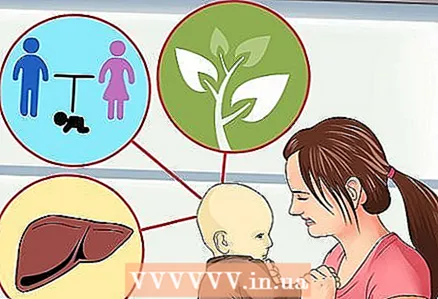 1 Assess the risk factors for developing hyperbilirubinemia in the infant. Factors such as genetic predisposition, environmental influences and several other health problems increase the likelihood of high bilirubin levels.
1 Assess the risk factors for developing hyperbilirubinemia in the infant. Factors such as genetic predisposition, environmental influences and several other health problems increase the likelihood of high bilirubin levels. - Babies born prematurely are less likely to be able to process bilirubin because their livers are underdeveloped.
- Babies whose blood type is incompatible with that of the mother (AB0 blood incompatibility) may be born with higher levels of bilirubin in the blood.
- If the baby is severely bruised during childbirth, the bilirubin level may rise due to the breakdown of red blood cells.
- Babies can develop "breastfeeding jaundice" for two reasons: the presence of certain proteins in breast milk, or because the baby is not getting enough fluids in the milk and is dehydrated.
- Some children may have health problems, such as liver, blood, or enzyme problems, which can also lead to elevated bilirubin levels. In addition, the infant's bilirubin levels may rise due to infection.
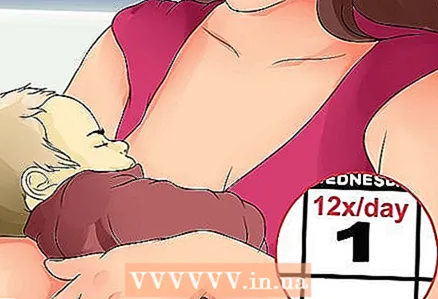 2 Feed your baby often. For jaundice, your doctor may recommend feeding your baby up to 12 times a day.
2 Feed your baby often. For jaundice, your doctor may recommend feeding your baby up to 12 times a day. - Fixation and sucking problems can cause the baby to receive less breastmilk, so consider consulting with a breastfeeding specialist who is trained to help breastfeeding mothers.
- Feeding your baby more often stimulates bowel movements, which helps to flush bilirubin out of the body.
- If more frequent breastfeeding does not help lower bilirubin levels, your pediatrician may recommend that you supplement your baby's diet with formula or expressed breast milk.
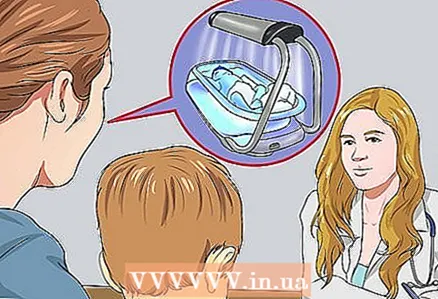 3 Ask your pediatrician about phototherapy. In phototherapy, the baby is exposed to light in the blue-green range of the spectrum. Light waves penetrate the skin into the bloodstream and convert bilirubin into another substance that the baby's body can remove.
3 Ask your pediatrician about phototherapy. In phototherapy, the baby is exposed to light in the blue-green range of the spectrum. Light waves penetrate the skin into the bloodstream and convert bilirubin into another substance that the baby's body can remove. - The baby's eyes will be covered with soft pads to protect them from light. It is also possible to leave a diaper on the baby during therapy.
- As a side effect of phototherapy, the baby is more likely to have watery, frequent, and possibly greenish stools. This is quite normal and should go away after the end of the course of treatment.
- Although direct sunlight can also help lower bilirubin levels, this treatment is not recommended because it is very difficult to measure and control the light intensity and body temperature of an infant during irradiation.
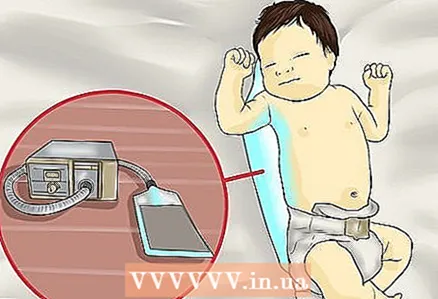 4 Consider using a biliblanket. It is a state of the art fiber optic phototherapy device.
4 Consider using a biliblanket. It is a state of the art fiber optic phototherapy device. - The bili blanket consists of a woven fiber-optic material that the baby is wrapped in, which illuminates the baby's body evenly. This allows treatment to be continued when the mother is holding the baby or breastfeeding.
- The baby's skin may look discolored or reddened after a blanket, but this effect is actually part of the treatment process and wears off when the bilirubin level decreases.
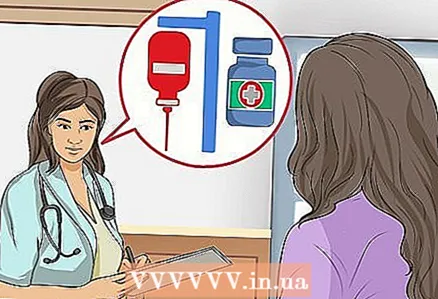 5 Talk to your doctor about other options. If the jaundice is caused by an infection or other health problem, such as accelerated breakdown of red blood cells, your doctor will likely recommend other treatments, such as medication or even a blood transfusion.
5 Talk to your doctor about other options. If the jaundice is caused by an infection or other health problem, such as accelerated breakdown of red blood cells, your doctor will likely recommend other treatments, such as medication or even a blood transfusion.
Part 2 of 2: Lowering Bilirubin in Adults
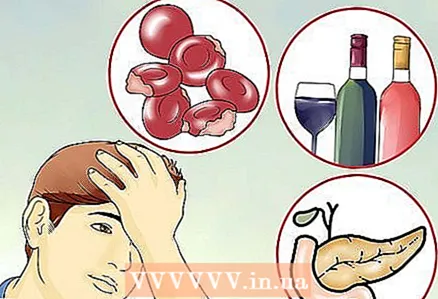 1 Assess your health status to understand what may have increased your bilirubin levels. The bilirubin system can run into problems at one of three stages: before, during, and after bilirubin production. Each of these problems can arise due to their respective diseases.
1 Assess your health status to understand what may have increased your bilirubin levels. The bilirubin system can run into problems at one of three stages: before, during, and after bilirubin production. Each of these problems can arise due to their respective diseases. - Adults can develop so-called "unconjugated jaundice" when the problem occurs before bilirubin is produced.It is most often caused by reabsorption of a large blood clot or hemolytic anemia.
- During the bilirubin production stage, adults may develop jaundice as a result of a viral illness such as hepatitis or Epstein-Barr virus infection, an autoimmune disorder, alcohol abuse, or certain medications, including paracetamol, oral contraceptives, or steroids.
- If jaundice in an adult develops due to problems during the post-bilirubin stage, it may be caused by problems with the gallbladder or pancreas.
 2 See your doctor. If jaundice occurs, the bilirubin level should be checked. Jaundice may indicate that you have a serious health problem. Usually, doctors try to identify and eliminate the cause of jaundice, as well as treat possible complications. There is usually no cure for jaundice itself. In some cases, medication may be prescribed to help relieve itching, a common symptom of jaundice.
2 See your doctor. If jaundice occurs, the bilirubin level should be checked. Jaundice may indicate that you have a serious health problem. Usually, doctors try to identify and eliminate the cause of jaundice, as well as treat possible complications. There is usually no cure for jaundice itself. In some cases, medication may be prescribed to help relieve itching, a common symptom of jaundice. - Other symptoms often accompany jaundice, which may help a doctor determine the cause.
- Brief jaundice caused by infection can be accompanied by chills, fever, abdominal discomfort, and other flu-like symptoms.
- If jaundice is caused by cholestasis, which is a disturbance in the flow of bile, it may be accompanied by itching, weight loss, dark urine, and light-colored stools.
- Other symptoms often accompany jaundice, which may help a doctor determine the cause.
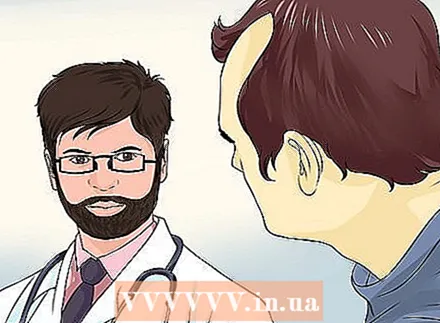 3 Make sure high bilirubin levels are not caused by a rare medical condition. Many rare diseases can increase bilirubin levels and cause jaundice.
3 Make sure high bilirubin levels are not caused by a rare medical condition. Many rare diseases can increase bilirubin levels and cause jaundice. - Gilbert's syndrome is a genetic liver disease. At the same time, the amount of liver enzyme required for the breakdown of bilirubin is reduced in patients. Although the condition is present from birth, its symptoms, which include jaundice, fatigue, weakness, and digestive problems, may not appear until adolescence.
- Crigler-Najjar syndrome is an extremely rare condition that is also caused by an enzyme deficiency. There are two types of this disease: the more common form, Arias syndrome, is treatable so that life expectancy of patients is not shortened or close to normal.
- The risk of developing jaundice is increased in those suffering from sickle cell anemia and other blood diseases.
 4 Limit your drinking. Alcohol is bad for the liver and can cause elevated bilirubin levels, so limit your alcohol consumption to 1–2 drinks per day (depending on your age). One serving equals 350 milliliters of beer, 140 milliliters of wine, or 40 milliliters of spirits. Some people may be advised to give up alcohol altogether. Alcohol can damage the liver in three ways:
4 Limit your drinking. Alcohol is bad for the liver and can cause elevated bilirubin levels, so limit your alcohol consumption to 1–2 drinks per day (depending on your age). One serving equals 350 milliliters of beer, 140 milliliters of wine, or 40 milliliters of spirits. Some people may be advised to give up alcohol altogether. Alcohol can damage the liver in three ways: - It leads to the deposition of excess fat in liver cells. This condition is known as fatty liver hepatosis. For many, it is not accompanied by any symptoms, although some patients experience discomfort and fatigue.
- Alcohol causes scarring and inflammation of the liver. These symptoms may indicate alcoholic hepatitis. Additional symptoms such as vomiting, abdominal pain and fever are also possible. Sometimes alcoholic hepatitis can be cured by abstaining from alcohol. This same condition can be caused by viral or autoimmune hepatitis.
- Alcohol interferes with normal liver function. Liver cirrhosis is characterized by severe scarring of the liver and impairment of its ability to process food and remove harmful substances from the blood.
 5 Maintain a healthy weight and diet. Studies have shown that obesity can do more liver damage than alcohol consumption. Obesity can lead to fatty liver hepatosis (even in children).
5 Maintain a healthy weight and diet. Studies have shown that obesity can do more liver damage than alcohol consumption. Obesity can lead to fatty liver hepatosis (even in children). - Foods that are high in fiber, including fruits, vegetables, and whole grains, are especially beneficial for the liver.
- Certain foods are more harmful to the liver, including foods high in fat, sugar, or salt. In addition, fried foods and raw or undercooked seafood can also damage the liver.
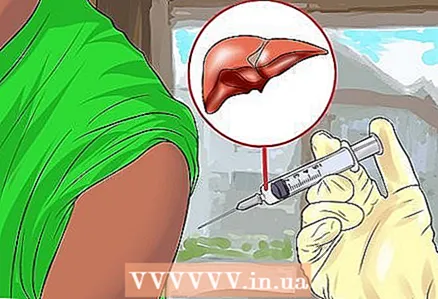 6 Protect yourself from hepatitis. Hepatitis A, B and C are viral diseases that negatively affect the liver. To avoid contracting them, take the following precautions:
6 Protect yourself from hepatitis. Hepatitis A, B and C are viral diseases that negatively affect the liver. To avoid contracting them, take the following precautions: - Hepatitis B vaccination is recommended for all babies soon after birth. Hepatitis A vaccination is recommended for those who are at high risk or who are going to visit high-risk areas.
- If you are going to visit areas where hepatitis is common, get vaccinated beforehand.
- Hepatitis can also be contracted through risky behavior, such as intravenous drug use or unprotected sex.
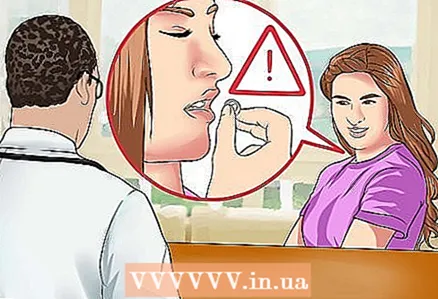 7 Be careful when taking medication. Remember that some medications, including over-the-counter pain relievers and common prescription medications such as cholesterol lowering drugs, antibiotics, and anabolic steroids, can cause toxic hepatitis. If you suspect that any medications you are taking may harm the liver, consult your doctor.
7 Be careful when taking medication. Remember that some medications, including over-the-counter pain relievers and common prescription medications such as cholesterol lowering drugs, antibiotics, and anabolic steroids, can cause toxic hepatitis. If you suspect that any medications you are taking may harm the liver, consult your doctor. - While many believe that some alternative medicines are good for the liver, they can actually damage the liver. Check with your doctor before taking these products. For example, herbal remedies such as green tea, intoxicating peppers (kava), comfrey, white mistletoe, chaparral, and skullcap can cause liver damage.
- Medicines are broken down in the liver, so some of them can damage this organ. For example, a popular over-the-counter drug such as paracetamol can cause liver damage.



